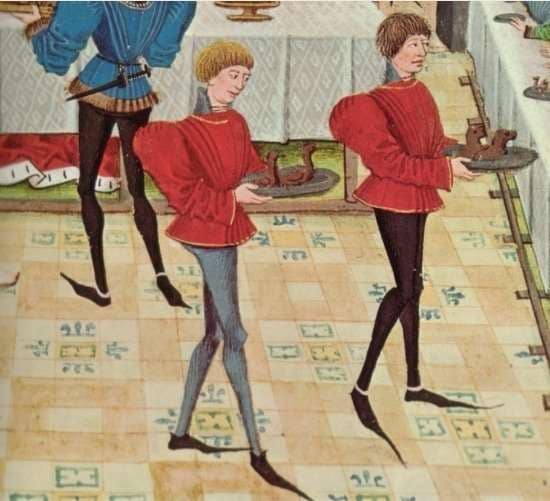“It’s a time when tunics are getting shorter and young men would have been showing off their legs…. So low-cut shoes would have accentuated and elongated the leg, all down to that long point.”
Men in fifteenth century Europe, their thighs and calves so swole and shapely in their medieval compression pants, were crazy for ‘crakows’ or ‘poulaines’ — a must-have pointy accessory for any young male keen to draw the eye.
Probably originating in Krakow, Poland, they were, according to an fascinating feature in Atlas Obscura, ‘long, carrot-shaped shoes that tapered to impish tips, some as long as five inches beyond the toe.’
This crakow craze was no short-lived fad — it lasted most of a century. In the middle ages people made the most of trends, since they didn’t have much in the way of media and advertising generating new ones.

Their impracticality and their expense seems, as is often the case with fashions, to have been part of the appeal of these stupendously silly shoes.
However, their probing phallicism seems to have been the main attraction — and what ultimately prompted a crackdown on cracows, in a manner reminiscent of the Speedo Phalliban of Cape May, NJ.
Eventually, the English crown felt the need to intervene, in part because of the lascivious connotations that the increasingly extended toe-tips carried. “People thought the longer the toe, the more masculine the wearer,” Shawcross says. “But some people weren’t keen on that connotation.” Parliament equated wearing the shoes to public indecency, and stepped forward to put limits on a variety of racy fashions…
A sumptuary law was enacted in 1463 which sought to control the flaunting of ‘piked’ footwear, restricting them to a decent, Christian length of two inches — and also draw a veil over the shameless display of genitals and buttocks in tights:
“No person under the estate of lord, including knights, esquires, and gentlemen, to wear any gown, jacket, or coat which does not cover the genitals and buttocks. Also not to wear any shoes or boots with pikes longer than two inches…,” the 1463 law reads.
The killjoy sumptuary clauses didn’t however ban such male indecency outright. Rather, they made it the prerogative of position. Lords and above were still allowed big poulaine energy — and to show off their noble bums and packets.
I followed the link to the 1463 law and found a fascinating essay called ‘Gender & History’ by Kim Phillips, which lists the various sumptuary clauses of medieval England, and includes an explanation of the mention of genitals and buttocks:
‘These clauses reflected the contemporary fashion among young men, trends which in the case of the short jackets neccessitated the invention of the codpiece to cover the part between the two stocking legs and met with howls of disapproval from clerical authors. This had been most vividly put by Chaucer almost a century earlier, in the voice of his Parson: ‘Alas, some of them show the bulge of their shape, and the horrible swollen members, that seem like the malady of hernia, in the wrapping of their hose; and also the buttocks of them looke like the hind parts of a she-ape at the time of full moon’.
I had forgotten that passage from Chaucer, but not of course the Parson, who is a timeless figure of fun. How naughty of Chaucer to have his goodly Parson admitting that he sees the buttocks of young men in tights transformed into the hind parts of female monkeys at the time of full moon.
As Philips explains, the ban on suggestive footwear and provocatively high cut jackets and coats, was strictly for the lower orders.
‘Scandalous and sexually suggestive items of male clothing were reserved by the English sumptuary texts for the aristocratic elite, implying that their rank exempted them from the morality applied to lesser mortals. Sartorial excess and blatant sexuality were permitted as a marker of elite masculinity.’
Presenting yourself as a ‘sex object’ was clearly associated with power in the middle ages.
Philips also points out that ‘the realm of high fashion and sartorial adornment was not primarily focused on women until the “great masculine renunciation” of the early 19th century.’ Which ended up with the boxy bourgeois uniform of the suit replacing all that display and adornment — and women now required to be beautiful and sensual on men’s behalf.
Unlike their Italian or Scottish counterparts, medieval English sumpturary legislators were relatively unconcerned about the dress of women: the focus for them was very much on men and what they were and weren’t allowed to wear. It’s also worth bearing in mind that in a homosocial world such as England in the middle ages, the sexually suggestive clothing, the presentation of buttocks and packets, was for the most part for the enjoyment or attention of other men. (Excepting, of course, Parsons.)
Much like today’s spornowear, in other words.
I’d like though to end this trip into the middle ages with Philips’ citation of an Italian woman’s inspiring protest against attempts by the sumptuary laws of that country to control feminine apparel — and deprive women of the intoxicating power of being looked at.
‘Most illuminating is the Bolognese noblewoman Nicolosa Sanuti’s ringing conclusion to her humanistic defence of the virtues of women and their rights to sumptuous clothing: “State offices are not allowed to women, nor do they strive for priesthoods, triumphs, and the spoils of war, for these are the customary prizes of men. But ornaments and the decoration, the tokens of our virtues – these while the power is left us, we shall not allow to be stolen from us. Amen.”
Amen, sister.

‘noble bums and packets’ sounds like an unwritten (or suppressed) Shakespeare play.
Comments are closed.